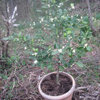Fertlizing: Frequency? Rate? When? How?
axier - Z10, Basque Country (Spain)
9 years ago
last modified: 9 years ago
Featured Answer
Sort by:Oldest
Comments (7)
mksmth zone 7a Tulsa Oklahoma
9 years agoRelated Discussions
My First Soil Test. Please help on Fertlizing Schedule!
Comments (7)Ah, OK, I thought perhaps I have having a bit of a psychotic break or something. Your calculation breaks down to well over 3 lbs of nitrogen (back, 4 in the front) per thousand square feet. For any synthetic (numbers like 20-10-10 will be synthetics), that's way, way, way too high. You run a very severe risk of burning the lawn and killing it off, even with the alkaline soil. I feed organically and won't exceed 1.5 lbs of nitrogen at one application--and organics aren't risky in that department. Burning is caused by an excess of salts in the lawn, and synthetics are very high in salt. That forces your lawn to reverse water out of the roots and into the soil (reverse osmosis, in other words), which renders it bone dry and kills it. Even if you got away with it, most of that nitrogen is either going to gas off the lawn, wash away into the rivers, or go into really excessive top growth. You don't want that as all three are a waste. One suggestion is to go organic, which has no salt, will help moderate your pH at the same time, and improves the soil--plus gets the N-P-K monkey off your back a bit. Oh, it also feeds gradually over time instead of one spike and then nothing. There's an entire forum about this (Organic Lawn Care) if you're interested. 'Nuff said. If you'd rather go synthetic, no more than 1 pound of actual nitrogen should be applied at one time (there are exceptions for warm season grasses, but you don't have those in Indianapolis anyway). Note, I wouldn't normally break things this way, but with an overseed coming up, I'm modifying things a bit. Others will have differing opinions and their timing isn't wrong, just different. I'm assuming you can get a fertilizer around 25-5-5 (about that of Turf Builder, Turf Builder plus Iron, and a thousand other off-name brands) for the below. There's nothing wrong with bargain fertilizer, and Vigoro does the same job somewhat cheaper. Store brand is usually one of the large companies and does the same job MUCH cheaper. If you get something different, the equations are: Take square footage in thousands (so your back yard is really 9 as I don't bother with minor decimal points, and the front is 3). Take the values from the bag as a decimal (0.25, 0.05, and 0.05). Take 1/bag value and then multiply by the square footage. That's the number of pounds per thousand square feet to apply to get 1 pound of a given nutrient. Generally I use nitrogen because that's the highest number on the bag. So 1/0.25 * 3 = 12 lbs of 25-5-5 in the front, or 4 lbs per thousand square feet of your fertilizer. That's exactly 1 lb per thousand of nitrogen. You can then calculate the other two values by: 4*0.05 = 0.20. So you're adding 0.20 lbs of phosphorous and 0.20 of potassium. Out back, 1/0.25 * 9 = 36 lbs, with the same pounds per square foot of everything going down. Or a grand total of 48 lbs over the whole lawn. OK, the math is done, we now return you to your normal schedule. In this one particular instance, you're planning on overseeding so I'm hearing that you have a weak lawn. Consequently, I'm going really high on this schedule. If you don't have a lot of bluegrass this schedule's a bit aggressive and I noted that below May 15: Apply 4 lbs per thousand square feet August 15: Use Starter Fertilizer instead to prepare for your overseeding (this isn't critical and you can use the other stuff instead if you like) September 15: Apply 4 lbs per thousand (skip if you don't have bluegrass) October 15: Same November 15: Apply either 4/thousand or use Winterizer at the correct rate (which you'll calculate) That's 5 lbs N for the year (very high), 1 lb phosphorus (more than enough) and 1 lb potassium (a bit trim, but still OK with your readings). Normally I'd never cut the September feed, but with seeding the August one will have to do. If you skip seeding and don't have bluegrass, skip August instead. Is that enough variables for you? ;-) If it's too confusing, let me know what type of grass you have and I'll take another shot at it....See Morecool-season grass (kbb & tall fescue) - Summer fertlizing?
Comments (7)I wouldn't. In fact, our Extension only promotes fertilizing lawns in fall, late fall...and possibly a light feeding in the spring. If you are having hot temps, your lawn is stressed. Never fertilize a stressed lawn. Wait until Labor Day and then give the lawn a good shot of nitrogen, and again in mid to late November. Don't use a slow release at that time. The plants need to take up as much N as they can and as quickly as possible to store in their roots over winter. That will ensure a really nice show come springtime. Also, your fescue creates new blades from little nubs, called tillers, at the crown of the plant. If there is ample nitrogen in the roots over winter, those tillers will keep multiplying as long as the ground isn't frozen, giving you a much thicker lawn in spring....See MoreGreenman28, mike, and all others, I need advise
Comments (21)I'd say leave them alone and feed them as normally you should according to the instructions on the label, especially as the trees were recently stressed. If the roots were damaged from the leaf stress, you should not be using high dose fertilizer while they are recovering as they will not be able to take it up fast enough so it will remain in the growing media. If the media dries out the salts from the fertilizer will burn the roots. The fertilizer burns when it is dry not when it is liquid. Roots usually grow really well in air pots once the plant has time to adapt to the repot. You might have to make sure you are watering enough as the media probably is drying fast with the airy, fast draining media and air pots, especially in a hot, dry, sunny, windy, climate. Did you soak the media before you planted the tree in it? It takes a while for the bark to be able to absorb water when it is new. You might have to water every day with those conditions and also more often because the bark is new and has not decayed yet to easily absorb and hold the water. You said the trees got stressed and lost their leaves while you were away. They probably were not watered enough as it would be hard to overwater in your mix in an air pot like you are using. Looks like a Rootmaker pot. The trees are probably just now recovering. The tops look healthy green in the pictures, so I think you should just leave them alone and have patience and the roots will grow to match the tops. Citrus trees grow in cycles with the roots, tops and flowers growing at separate times throughout the year. When they look like they are not growing, that is usually when the roots are growing. Be patient, try watering a little more often, and fertilize per directions until the trees get stronger and used to their new growing conditions. The higher dose fertilizer may also be causing them to push new growth too fast with the high level of nitrogen you are giving them resulting in weak growth. Slow it up and let this new growth harden up. Also, if the cutting was taken from a sideways growing branch rather than a verticle growing branch, it's growth will have more of a tendency to grow more horizontally and weepy rather than more upright. Good luck. I think you will have great success in the Rootmaker pots. Cory...See MoreAl...fertlizer question about bonsai.
Comments (6)Hi, Fred. Plants vary more in the volume of nutrients they use per mass than the ratio. On average, plants will use around 6x as much N as P and about 3/5 as much K as N. Because P and K are reported as the % by weight of phosphorous pentoxide and potassium oxide respectively, the reported amounts on packaging need to be multiplied by factors of .43 for phosphorous and .83 for potassium. So 3:1:2 ratio fertilizers actually supply P and K relative to N at a ratio of about 3: .43: 1.66, which is very close to the 6x as much N as P and 3/5 as much K as N. You'll encounter a few plants that prefer something quite different than the all purpose 3:1:2 ratio, but usually you can still use the 3:1:2 ratio fertilizer and accommodate the plant's known preference by supplementing with another nutrient delivery vehicle. E.g., hibiscus doesn't like much phosphorous, but does like more potassium than the average plant, so when I fertilize Hibiscus, I add 1/4 - 1/2 tsp of KCl to a gallon of what I normally fertilize with. If we assume that bonsai practitioners recommend 1:1:1 ratio fertilizers, we need to keep in mind that the fertilizer's ratio or NPK %s don't determine how much N your plant gets - YOU do. So if you see signs of a N deficiency, what do you do? You add more N. If you're using a fertilizer with a ratio that closely mimics usage, all is fine - your plants get enough N, P, K, and the rest of the nutrients, assuming they're IN the fertilizer and PROPORTIONED to N usage. If you're using a 1:1:1 ratio and are keeping up with N needs, it follows that you'd need to be supplying more P and K and likely all other nutrients than necessary, contributing to an unnecessarily high level of EC/TDS in the soil solution and opening the planting to the potentiality of antagonistic deficiencies, which would also relate to watering habits. I don't usually listen too closely to experts that don't tell you WHY they do what they do or why you should mimic their strategies. If you do a net search with the words walter pall 20-60, you'll discover that he applies 20-60 times the amount of N as the average grower by fertilizing at twice the rate recommended every 10 days. For years, I've been offering comments that reflect my practice of fertilizing with 9-3-6 at 2-3 times the recommended rate weekly (2-2.5 tsp/gallon when mean temps are 65-80*), and I'm thinking you've seen some of my trees that illustrate they're doing fine in depts. related to growth rate, health, appearance. Alex Shigo, PhD (a really famous tree guy - you should know him if you don't already) said, "A tree [plant] that is not growing is dying". And that can only be true. There is no balance in nature. A plant that is turning sunlight into more energy (food) than it uses is growing. A plant that ISN'T, one that's using more energy than it's manufacturing will always die unless the trend is reversed. A plant's state of vitality is a byproduct of its metabolism, so trees that are growing well are much easier for bonsai practitioners to keep happy/healthy/attractive. The next time someone recommends a 1:1:1 ratio fertilizer - ask why it's recommended. The answer will likely be because other fertilizers (like 3:1:2 ratios) have too much N. Then hit them with, "Isn't it the grower that determines how much N the plant gets?" and see how the question is fielded. Discussions about nutrition come up so frequently that I actually took a few minutes to consider how a hypothetically perfect nutritional supplementation program might be described. This is what I came up with: Nutrient Supplementation - Objectivity Whenever we discuss what is or isn't an appropriate part of the methodology we use to make certain our containerized plants get all the nutrients essential to growth and good health, we would probably first want to be sure our objectives are on target. It's difficult to argue with the idea that our focus in supplying supplemental nutrition to our plants should be on ensuring all the nutrients plants normally assimilate from the soil are A) IN the soil and available for uptake at all times, B) in the soil at a favorable ratio - that is to say in a ratio that mimics the ratio at which the plant actually uses the nutrients, C) at a concentration high enough to ensure no nutritional deficiencies, yet still low enough to ensure the plant's ability to take up water, and the nutrients dissolved in that water won't be impeded (by a high concentration of solubles in the soil solution). At this point, you can accept these premises as worthy goals or argue against them. If accepted, we should then necessarily examine our efforts at supplementation in the light of whether or not our efforts bring us closer to or limit our ability to see the goals implemented. *********************************************************************************************** Obviously, 1:1:1 ratio fertilizers wouldn't pass muster because no plants use nutrients in a 1:1:1 ratio which also ensures the EC/TDS of the soil solution will be higher than necessary in order to prevent deficiencies of at least N and K, but most likely other nutrients not supplied as a function of N usage. Is this going to kill your plants? No Make them observably deficient in growth rate, productivity, appearance? Possibly, but not likely for the average hobby grower. Is there a better way that affords plants greater opportunity to realize more of their potential? Yes Al...See Morezwoydziak9bsunset13
9 years agoaxier - Z10, Basque Country (Spain)
9 years agolast modified: 9 years agoIrene
8 years agolast modified: 8 years agoaxier - Z10, Basque Country (Spain)
8 years agojaydub83
5 years ago
Related Stories

GARDENING GUIDESWhen and How to Plant a Tree, and Why You Should
Trees add beauty while benefiting the environment. Learn the right way to plant one
Full Story
GREEN BUILDINGWhat's LEED All About, Anyway?
If you're looking for a sustainable, energy-efficient home, look into LEED certification. Learn about the program and its rating system here
Full Story
GARDENING FOR BUTTERFLIESGardening for the Bees, and Why It’s a Good Thing
When you discover how hard bees work for our food supply, you may never garden without them in mind again
Full Story
WINDOW TREATMENTSA Surefire Way to Prevent Sun Damage Indoors
Why let light ruin your furniture, floors and artwork, when the solution could be as simple as applying high-quality window film?
Full Story
REMODELING GUIDESWisdom to Help Your Relationship Survive a Remodel
Spend less time patching up partnerships and more time spackling and sanding with this insight from a Houzz remodeling survey
Full Story
GARDENING AND LANDSCAPINGSee a Soothing Backyard Bathhouse Born From a Salvaged Tub
Creative thinking and DIY skills give a Portland couple a pergola-covered 'hot tub' under the stars
Full Story
LIGHTINGWhat to Know About Switching to LED Lightbulbs
If you’ve been thinking about changing over to LEDs but aren't sure how to do it and which to buy, this story is for you
Full Story
BATHROOM DESIGNHow to Choose the Right Toilet
Style, seat height, flushing options, color choice and more will help you shop for the right toilet for you
Full Story
MOST POPULARWhat to Do After a Hurricane or Flood
How you treat your home after a natural disaster can make all the difference in its future livability — and your own personal safety
Full Story
REMODELING GUIDESHave a Design Dilemma? Talk Amongst Yourselves
Solve challenges by getting feedback from Houzz’s community of design lovers and professionals. Here’s how
Full Story




axier - Z10, Basque Country (Spain)Original Author